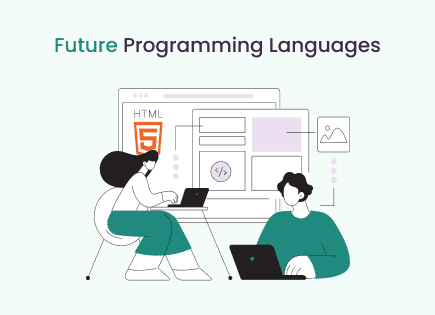Table of Content
10 Frontend Frameworks That Will Define 2025 and Beyond
Table of Content
 The average person visits 130 websites a day!
The average person visits 130 websites a day!
But they don’t spend the same amount of time on every one of them…so what’s the decisive factor that makes you scroll on Instagram all day but not even visit other sites for more than five seconds?
The user experience!
As 2024 draws to a close and 2025 starts off, more and more people are demanding personalized web experiences. They’re also using mobile devices to explore products and book services.
So, having an interface that catches your users’ attention and provides them with an unforgettable experience is critical to your success.
And in this blog, I’m going to tell you how you can achieve that success with the right frontend framework.

From popular frameworks like React and Angular to upcoming ones like Foundation and Semantic-UI, we’ll discuss the most commonly used frontend frameworks that will define 2025 and beyond…
Let’s dive in!
What is a Frontend Framework?
Frontend development is the process of building a website's graphical user interface, which users see and interact with. So, if you love seeing the interface of a website like Instagram or X (formerly Twitter), it’s the frontend development at work.
Usually, all frontend development utilizes three languages:
HTML for declarative purposes
CSS for giving the page a structure
JavaScript to execute event-based commands
So, where do frontend frameworks figure in all this? Well, front end development frameworks are sets of pre-written code that help developers structure and scale up a website without having to write the code from scratch.
Front end frameworks contain blocks of HTML, CSS and JavaScript codes that you can use and reuse for different projects. Here’s how this can help you:
It can generate HTML and CSS code for new or ongoing projects.
It can empower you to create responsive designs for multi-device optimization.
You can structure websites and apps for a consistent user experience using a frontend framework.
With a front-end framework, you can automate mechanical and repetitive programming tasks and even periodically update your code.
The best frontend webdev framework combines these features with a simple syntax and easy-to-understand structure.
The Frameworks That Will Define 2025 and Beyond…
To help you quickly scan through this list, I’ve used a uniform format to describe each framework. For each framework, you’ll find the following:
A brief description of the framework
Popular companies using the framework
Standout features of the framework
When to use the framework
When not to use the framework
Find out which framework was built for you:
1. React
React is an open-source Javascript frontend framework and library maintained by Meta along with inputs from individuals and other companies. As of 2024, it was the single most popular framework used by web developers.

React relies on components like “Thumbnail,” “LikeButton,” or “Video” to help you build simple but effective user interfaces. After you build individual components using React’s library, you can add them to an entire app or web page.
Some of the world’s most recognized websites like Netflix, Airbnb, Facebook and X (formerly Twitter) are built using Reactjs enterprise app development services!
Standout Features of React:
It follows a Declarative paradigm for building interfaces for any type of content.
It comes with Modular and reusable entities called “components” that form the many layers of React-powered applications.
It uses Function components that help you make your user interface without affecting its content.
It provides React hooks that empower you to isolate the reusable parts of your application.
It follows a Virtual Document Object Model that enables web pages and apps to load faster.
When to use React:
You need to include dynamic content with your website or app.
You’re building a social networking website.
You require an extremely SEO-friendly website.
For building data visualization tools and dashboards.
When Not to Use React:
Your project has very simple requirements without any dynamic content.
You need an extremely lightweight application (use Vue instead.)
Your app or website involves sophisticated admin panels (we suggest using Django.)
If React speaks to you as your preferred frontend framework, we suggest you pair it with Next.js or Remix for full-stack development.
2. Angular
Angular is an open-source Typescript-based framework maintained by Google and a community of developers and corporations. As of 2024, nearly 20% of developers used it to build complex and visually appealing websites and apps.

Google’s main objective in designing it was to help people build single-page applications. However, over time, Angular has been used to build complex applications with simple frontends like Gmail, Upwork, PayPal and Forbes. Angular is widely recognized as one of the most performant frontend frameworks around.
Let’s understand why so many people are after custom Angular development services.
Standout Features of Angular:
It uses modular components that allow you to build reusable interface elements.
Its data binding feature reflects any changes in the view are made to the model.
Through Dependency injection, it makes it easier for you to test websites and apps.
Through Server-side rendering, Angular improves load times and website performance.
Angular comes with a Router component that makes it easier to build single-page applications without complex Routing.
It can be used for both frontend and backend development.
When to Use Angular:
You want to build a video streaming like Netflix or a user review app like Yelp.
You want to design an interactive app like a weather app or a travel app.
You want to create a jobs portal app that can handle a lot of data, posts, or user information.
Angular is the perfect framework for heavy-duty enterprise app development.
When Not to Use Angular:
You want to build fast-loading applications or websites.
You don’t need a performance-heavy framework.
Your website or application will not have sophisticated features.
If you’re planning to deploy your application or website using Angular, we recommend using it with Ruby on Rails as the backend framework.
3. Vue.js
Vue.js (pronounced “view”) is a model-view-viewmodel language that helps users separate the frontend of their website from the backend or logic-end. It is an open-source framework maintained by a core community of active users.

Vue’s core focus is on websites' frontends, or user interfaces. It focuses on two aspects of programming: declarative rendering and component composition. It is a lightweight alternative to Angular built by Evan You, a former Angular developer.
As of 2024, it was used by more than 16% of all developers and has powered websites like Netflix, Adobe, Trivago and Xiaomi. This makes it one of the most commonly used frontend frameworks around.
Standout Features of Vue.js:
Extends basic HTML elements via components to build reusable code.
Comes with Template-based syntax that responds to specific data rendered by the Document Object Model.
Has a library of transitions and animations to help developers build rich interfaces.
Its Routing feature overcomes the traditional limitations of Single-Page Applications in sharing links to other websites’ subpages.
Vue.js’s Reactivity helps the webpage understand when and how to re-render components.
When to Use Vue.js:
You’re using Node.js as your backend framework.
You want to use Qausar or Tauri codebases to build your mobile or desktop app.
For building interactive single-page applications.
You need a declarative replacement for jQuery.
When Not to Use Vue.js:
You want to build a scalable website or app.
You intend to integrate a lot of plugins into your website.
You need to reflect real-time changes in your backend on your frontend.
You require a framework with a large community of developers.
If you’re tempted to use Vue.js for your web infrastructure development, we recommend using Django, ExpressJS or pocketbase.io as your backend framework.
4. jQuery

jQuery is a popular Javascript library that simplifies HTML document traversal, event handling, animations and Ajax requests. It is licensed under the open-source MIT license and is a feature-rich language used by more than 20% of all programmers.
Some of the world's most popular websites, such as Cloudflare, WordPress, Vimeo and Spotify, use jQuery to build their frontend interfaces. As of 2018, it was used by nearly 80% of the top 1 million websites on the Internet.
However, as browsers begin to provide more and more of jQuery’s functionality through native features, its usage is declining. So, let’s find out if jQuery is still the right framework for your project.
Standout Features of jQuery:
The DOM-based rendering creates nodes in response to elements’ names and attributes.
Ajax support helps you send and retrieve data without interfering with the existing UI of your webpage or app.
jQuery is known for its Extensibility through support for a wide variety of plugins.
Its feature detection that automatically checks which browser the viewer is using to access your website.
Provides cross-browser support to help your websites load on any device or browser.
When to Use jQuery:
You want to build dynamic and responsive websites.
You need a framework that can handle AJAX requests and detect events.
You want to build a website with popups on the homepage.
Your project requires a fast development timeline.
When Not to Use jQuery:
Your app or website doesn’t require event detection.
You want light apps or websites that load quickly.
You want to build large or complex websites without affecting the Document Object Model (DOM.)
The features of jQuery that you want are already supported by browsers like Chrome, Mozilla and Safari.
If jQuery seems like the right framework for your project, try using it with Express.js, Nest.js or Meteor.js.
5. SolidJS

SolidJS is one of the youngest front end frameworks on our list. It is a highly reactive framework similar to React but has simpler rendering capabilities and offers faster performance.
One of the reasons that SolidJS has gained a lot of popularity in a short time is that it provides fine-grained reactivity, and its components don’t re-render unless the JSX expressions and primitives are updated. This massively increases the speed of apps and websites written in SolidJS.
In its short time on the market, SolidJS has become one of the most admired frameworks. This is helped by the fact that websites like Shopify and ChatGPT have used SolidJS to program their frontends.
Standout Features of SolidJS:
It provides fast UI support and efficient memory utilization.
It is made up of composable reactive primitives to help you build hyper-interactive apps.
It converts your components into JavaScript code to bring them as close to the Document Object Model as possible.
SolidJS provides form validations and CSS code for building websites with dynamic content.
It uses JSX to render HTML code within a browser.
When to Use SolidJS:
You need complete control over the update system of your online ecosystem.
You want to make an app or website with a complex dashboard (like an enterprise project management app or a logistics app).
You require a framework that can help you scale your app and website in the future.
You want to build a lightweight and minimalistic application or website.
When Not to Use SolidJS:
You need a framework with extensive support and library integrations.
You require a framework with a simple debugging experience.
Your programming team isn’t experienced with SolidJS: since SolidJS is a newcomer on the scene, handling its downsides can be very challenging.)
If SolidJS seems appealing for your project, you can pair it with any JavaScript backend framework. we recommend Supabase or NodeJS.
You May Also Like: Next js vs Node js: Choose the Right Framework for App Development
6. Backbone.js
Backbone.js is an open-source front end framework for building single-page applications and synchronizing different parts of web apps. It uses an imperative style rather than the declarative style used by Angular.

Backbone.js’ primary strength is helping you build rich user experiences for your websites. It is particularly useful if you want to create apps and websites that involve heavy Document Object Model manipulation.
As of 2024, several companies, such as Netflix, Airbnb, Verizon, and others, use it to power their websites. Let’s find out why…
Standout Features of Backbone.js:
It follows the Model-View-Controller approach to programming.
It is pre-configured to sync with RESTful API and event-driven communication.
It allows you to make independent decisions regarding the architecture and development of your app or website.
Backbone.js automatically updates the HTML side of your website.
It is supported by extensive community support and a powerful library.
When to Use Backbone.js:
You want to create a single-page app without expansive dependencies (like Gmail.)
You require a framework that offers a Model-View-Controller approach.
You need a website or an app with a smooth and rich UX.
When Not to Use Backbone.js:
You need a declarative programming framework.
Your app or website will rely on large data structures.
Your app or website requires dynamic content.
While Backbone.js doubles as a frontend and backend framework, we suggest you try Node.js or Drupal as its backend complement.
7. Ember.js

Next on our list of the top 10 frontend frameworks that will define 2025 is Ember.js. Although Tide Inc. owns its trademark, it is still an open-source Javascript frontend framework designed to help developers create scalable one-page applications and websites.
Following in the footsteps of Ruby on Rails, Ember.js follows the Don’t Repeat Yourself and Convention-Over-Configuration principles. It was designed with four main ideas in mind: first, to provide a client-side solution for web app development; second, to increase productivity on the development stack; third, to prioritize backward compatibility; and fourth, to meet the web standards of the future.
Ember.js is a hugely popular programming framework that powers websites and applications such as LinkedIn, Twitch, Apple Music and Nordstrom.
Standout Features of Ember.js
Ember.JS uses Routes that are associated with different URLs; the route object is visible to the user.
Ember Data helps you handle server requests and load JSON objects.
Ember Templates build the HTML side of your website or application.
Ember Components empower you to build interactive and event-driven websites.
Ember.js follows a declarative one-way data flow model.
When to Use Ember.js:
You want to build a complex application with dynamic content.
Your app or website needs to access multiple sources at once.
You need a framework that uses the Model-View-Controller approach.
When Not to Use Ember.js:
You don’t want unit testing features (Ember.js automatically generates unit tests.)
Your project won’t involve updating dependencies.
You don’t like the native JavaScript functionality.
The best server-side frameworks for Ember.js include Rails, Node.js and Django.
8. Svelte

Svelte is an open-source framework written in JavaScript. However, it is not a monolithic JavaScript library. It is a component-based framework that compiles HTML templates to directly manipulate the Document Object Model using specialized code.
It offers a faster runtime than Vue.js or React by eliminating the need to interact with Virtual DOM. It is also the framework with the smallest bundle, at just 2KB!
Svelte also occupies a special place in the developer community. The 2024 Stack Overflow survey suggests that more than 75% of programmers want to keep working with Svelte. In fact, even Stack Overflow’s internal team loves the framework. It’s no surprise that it is used by Spotify, Red Bull, the New York Government, and Ikea!
Standout Features of Svelte
Its self-contained and reusable components help you create complex user interfaces.
The smaller bundle sizes of Svelte reduce runtime and the data to be downloaded by your app or website.
Simplified State Management with reactivity is inherent to Svelte’s syntax.
It works directly with DOM to help reduce memory usage and boost performance.
Its transitions provide a great user experience by entering and leaving the Document Object Model as seamlessly as possible.
When to Use Svelte:
You want to compress the size of your applications.
You need to create a website or an app for low-power devices or emerging markets.
You require a framework that can support a variety of workflows.
When Not to Use Svelte:
You don’t want to build a feature-heavy application or website.
You want to integrate a lot of plugins with your website or app.
You want to isolate components and prevent them from interacting with other components.
If you want to use Svelte for frontend development, we suggest you build the backend using Beego, Gin, Fiber or Echo.
9. Semantic-UI

Semanit-UI is one of the most exciting frontend frameworks for building vivid user interfaces. It offers several templates, elements and views for building your website’s UI.
It tailors its code using CSS and jQuery and is a very easy framework to learn. It is also designed to provide a lightweight experience to users, consuming minimal memory while remaining high on performance.
Some of the early adopters of Semantic-UI include Snapchat, Geeksforgeeks, and Click Funnels. Let’s check out how it stacks up.
Standout Features of Semantic-UI:
It uses human-friendly HTML code that treats words and classes as interchangeable.
Its intuitive JavaScript phrases trigger functionality just like complex code.
The performance logging feature helps you detect errors without bottlenecks.
The High-level theming variables give you complete freedom over design.
Its reusable UI components can be deployed anywhere after they are compiled.
When to Use Semantic-UI:
You want to create a powerful CSS user interface.
You need a library with an extensive range of pre-built components.
You require a framework that treats words and classes as interchangeable concepts (human-friendly HTML code.)
When Not to Use Semantic-UI:
You want to build large and complex applications.
You require an efficient framework that uses less memory and space.
Your project requires a calendar and a “datetime picker” component.
You need draggable modals.
If Sematic-UI seems like the frontend of your dreams, I’d suggest Ruby on Rails, Django and Laravel as the backend complements.
10. Foundation Framework

Foundation Framework is an open-source framework based on the ZURB-style guide. It uses HTML, CSS and Javascript code to help you craft intuitive user interfaces. It uses CSS media queries and is the best framework for mobile-first development.
However, you can create websites and apps that can be viewed and used across devices without losing any of their functionality. Foundation works especially well for dynamic websites because It removes unnecessary wait times while loading transitions and animations.
As of 2025, it is used by Mini Cooper, Pixar and Barclays Bank to power their websites. So, from animations to cars to finance, it’s suited to a diverse range of requirements.
Standout Features of Foundation Framework:
It comes with a robust and flexible responsive grid to help you build interactive interfaces.
It has several “modals,” components, and elements that developers can use as plugins to code UIs.
Its components are modular, so you can reuse your interface and its components after you’ve compiled them.
A dedicated functionality helps you write HTML-based emails that can be read on any device.
It’s a mobile-first framework that scales up to bigger devices and screens.
When to Use Foundation Framework:
Your website or app requires date and time calculations.
You need a highly responsive front-end framework.
You want a framework that is mobile-first but can be scaled to desktop views.
When Not to Use Foundation Framework:
Mobile optimization is not your priority.
You have a strict development timeline to adhere to.
You require a framework with a wide range of community support.
If Foundation Framework looks like the right frontend framework for you, we recommend using Django, Spring Boot or Laravel as the backend framework.
Which Framework Will Define Your 2025 and Beyond?
As we conclude our discussion of the top 10 frameworks that will define 2025 and beyond, we hope you’ve found the one that stands out to you.
From React to Angular and Vue.js to Svelte, we’ve examined frameworks that are suited to different goals, development speeds, and the complexity of your app or website.
I recommend that you consider your team's expertise, the scale of your project and the features you need before deciding which framework to use.
If you’re still unsure which frontend framework suits you best, connect with us! From immersive travel apps to vivid logistics websites, we’ve worked with enterprises across a diverse range of industries to build and deploy visually attractive and feature-rich online ecosystems.
And we can do the same for you… Our state-of-the-art front end development services are designed help you understand which framework can help you build the website and app of your dreams!
Looking to transform your web app projects?
Explore top frontend frameworks to supercharge your projects and stay ahead in development.
Hire Now!
FAQs
Here are the frameworks that will define the future:
React: Component-based language for developing dynamic websites and apps.
Angular: Module framework for building hyper-interactive websites.
Vue.js: Reactivity-based framework for developing immersive single-page websites or apps.
According to the latest trends, React, Angular and SolidJS will be the most popular front end frameworks in 2025. These frameworks equip you with a modular and reactive approach to building frontends for websites and apps.
Svelta is more suited to medium-sized development projects than React. Svelte is also great for building low-energy-consuming applications for emerging markets. React, on the other hand, is more useful for large-scale projects that require several features. It is also suitable for building complex social networks and responsive websites.
No, Next.js cannot replace React. While some of their functionalities (like Routing) overlap, Next.js is better for server-side rendering and automatic code splitting, whereas React is better for speeding up the performance of your website or application.
Gatsby, Hugo, and Nextjs are some of the best frameworks for building static websites. The central defining feature of these frameworks is that they allow you to reuse HTML code. Out of all the options, Gatsy is the most performant frontend framework for a static site.
Related Blogs

Top 10 Backend Frameworks You Must Know in 2025
Are you looking to develop a groundbreaking mobile or web app but don’t know which backend framework to ch...

How to Upgrade Strapi 4 Project to Strapi 5? - A Guide by Experts
If you are one of the over 10 million people who use Strapi to power their project, we’ve got some good news: Str...

Top 17 Future Programming Languages 2025-2030
Over the past decade, our computing capabilities have improved radically and coding languages have evolved at ...
















